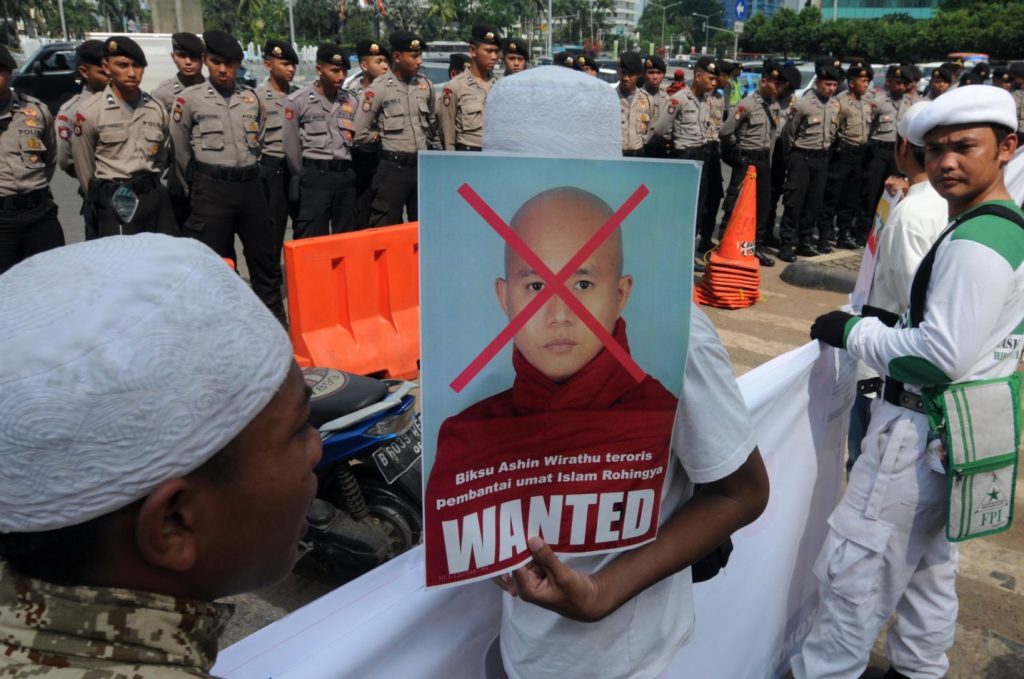Nothing is permanent, so everything is precious. Here’s a selection of some happenings—fleeting or otherwise—in the Buddhist world this week.
Myanmar Issues Arrest Warrant for Buddhist Nationalist Ashin Wirathu
A Myanmar court has issued a warrant for the arrest of the infamous Burmese Buddhist nationalist Ashin Wirathu on sedition charges after he took a break from his usual anti-Muslim fear-mongering to criticize the controversial leader of the country’s civilian government, Aung San Suu Kyi, according to the New York Times. Authorities in Myanmar have long ignored the extremist monk—dubbed the “Buddhist Bin Laden” by critics—and his hateful sermons against Muslims, a minority group in the majority Buddhist nation. His tirades took on a new significance in 2017, when the country’s military began a genocidal campaign of violence against the Rohingya, a Muslim ethnic group in Rakhine State. More than one million Rohingya refugees have since fled to camps across the border in Bangladesh.
Suu Kyi, a Nobel laureate who was once praised as a nonviolent advocate for human rights, has been widely criticized for her refusal to challenge the military’s brutal campaign and, at times, has appeared to help cover up or defend the atrocities. However, in his allegedly defamatory remarks against the leader, Wirathu said that she has been hindering the military’s attacks on Muslims and that her government was secretly supporting a Muslim agenda.
Related: Who Is the Real Aung San Suu Kyi?
As of Friday, police had yet to arrest Wirathu, who on Wednesday appeared to taunt the government, telling the Times, “I’m in Yangon. I am not hiding. They can come arrest me. I’m not afraid of prison.” On Thursday, at least 300 of Wirathu’s supporters gathered at Yangon’s Shwedagon Pagoda, one of the most sacred sites in Myanmar, to protest the arrest warrant.
US Ambassador Urges China to Speak with the Dalai Lama
During a rare visit to Tibet on May 25, US Ambassador to China Terry Branstad urged the Chinese government to enter into dialogue with His Holiness the 14th Dalai Lama. At the first visit to Tibet by a US ambassador since 2015, Branstad met with Chinese and Tibetan leaders and “encouraged the Chinese government to engage in substantive dialogue with the Dalai Lama or his representatives, without preconditions, to seek a settlement that resolves differences,” a spokeswoman for the US Embassy in Beijing said in a statement to Reuters. The Dalai Lama fled Tibet in 1959 and has been living in exile ever since. Three days after Branstad’s meeting, a Chinese government spokesperson said that they will not be pressured into holding talks with the Tibetan leader, remarking that Beijing “firmly opposes any foreign interference in Tibet affairs in China’s domestic affairs,” according to Phayul.com.
Bodhisattvas Sell for $5 million at Buddhist Art Sale
A pair of standing bodhisattvas sold for the highest price at $5 million on the final day of Christie’s spring sales in Hong Kong, according to the art auction news website The Value. The Glories of Buddhist Art auction garnered around $15 million for a total of 15 artworks. Measuring around five feet tall and dating somewhere between the 10th–12th centuries, the wooden figures depict Guanyin, the bodhisattva of compassion, and Mahasthamaprapta, a bodhisattva-mahasattva, or great bodhisattva, who represents the power of wisdom. Following the bodhisattva duo in price was an 18th-century gilt-lacquered wood statue of the Medicine Buddha. Although originally from Kyoto, this large buddha figure sat in a luxury home-furnishing store in San Francisco called Gump’s for over 50 years. Other artworks at the Christie’s sale included a 14th-century gilt-copper figure of Manjushri, a bodhisattva associated with insight or wisdom, and a large grey stone head of the Buddha dating to the 14th–16th centuries. The results of the auction reflect Chinese buyers’ newfound interest in Buddhist art, a phenomenon that the New York Times has reported on in recent years.
The “Sistine Chapel” of Tibet comes to New York City
On May 29, the Tibet House in New York City launched their summer art exhibit “Body of Light,” showcasing a collection of paintings by Nepalese artist Romio Shrestha. The works depict the mural paintings of the Lukhang Temple, reportedly referred to as the “Sistine Chapel” of Tibet, according to a press release. The temple was constructed by the Fifth Dalai Lama as a three dimensional mandala and was used to indoctrinate the Dalai Lamas into tantric meditations. Due to the esoteric nature of the temple, the murals were rarely seen by those uninitiated into Vajrayana Buddhism. Shrestha’s art is also in the permanent collections of The British Museum and the Victoria and Albert Museum in London, and the American Museum of Natural History in New York. The current works on display in Tibet House are on view until July 23.
Thank you for subscribing to Tricycle! As a nonprofit, we depend on readers like you to keep Buddhist teachings and practices widely available.
